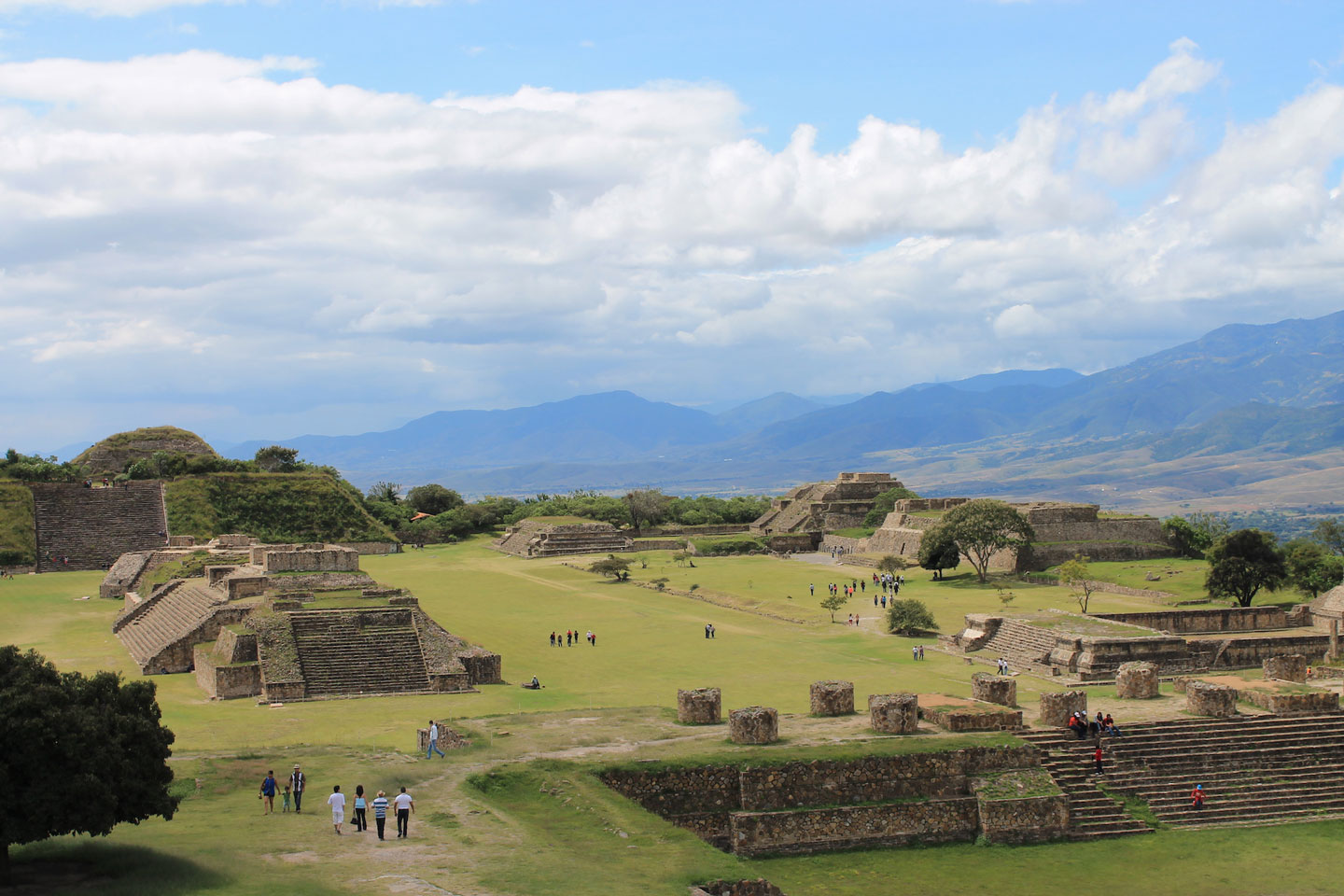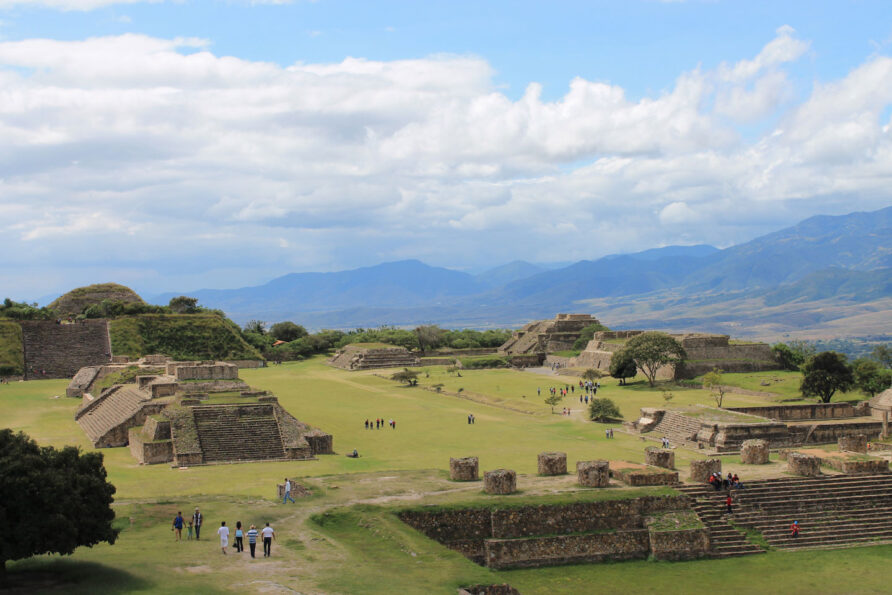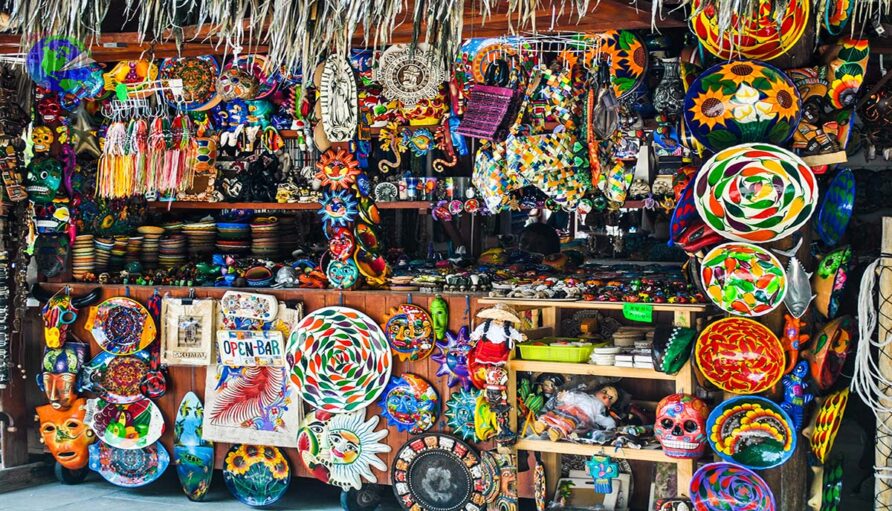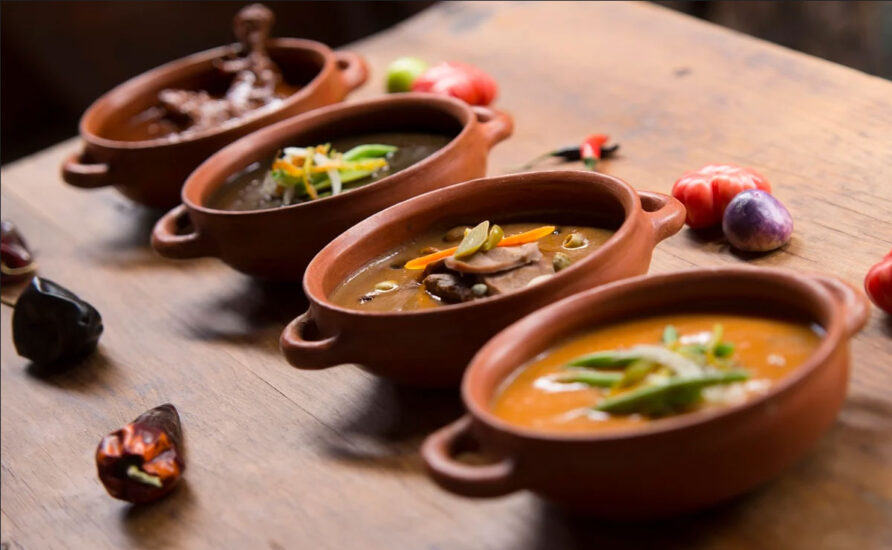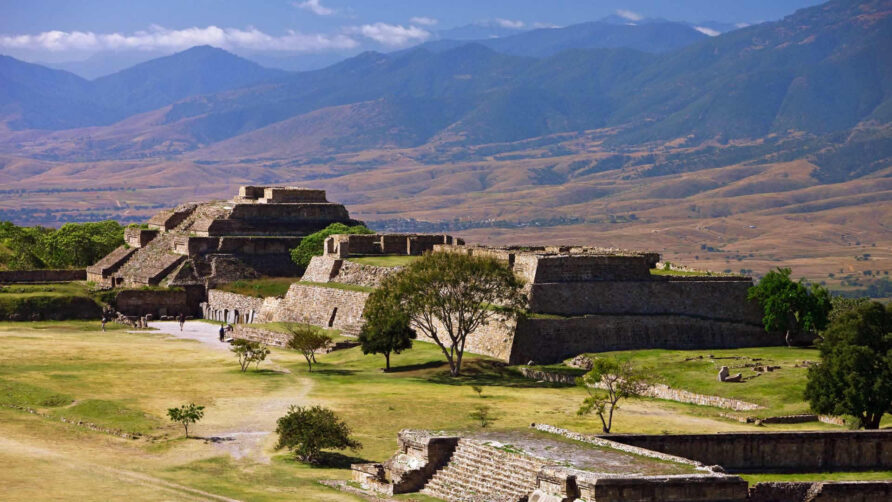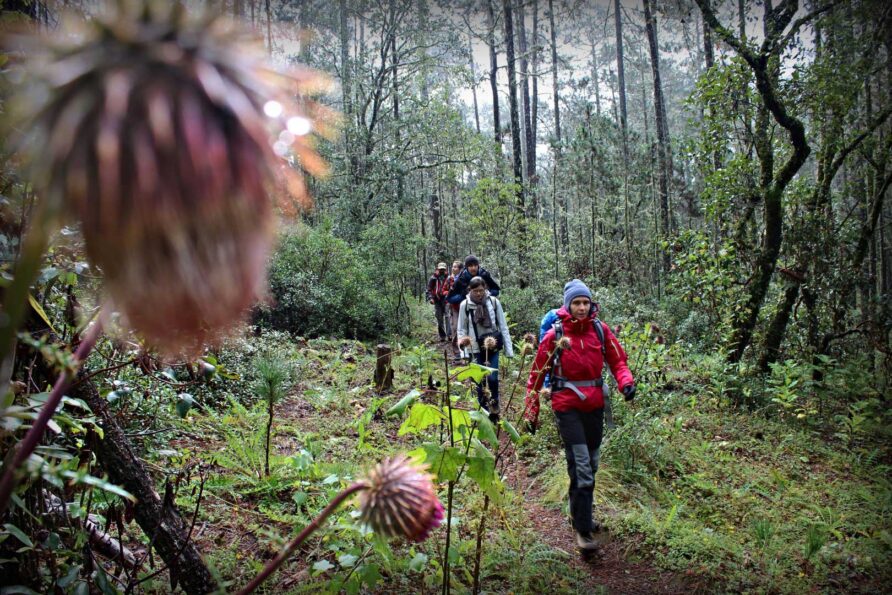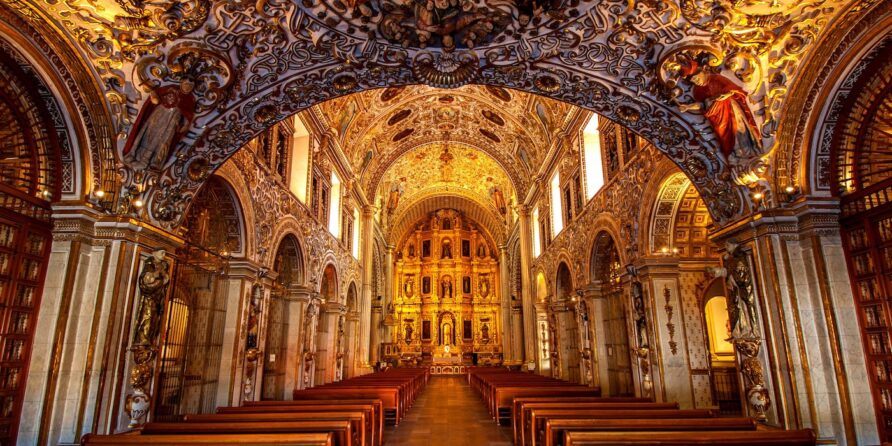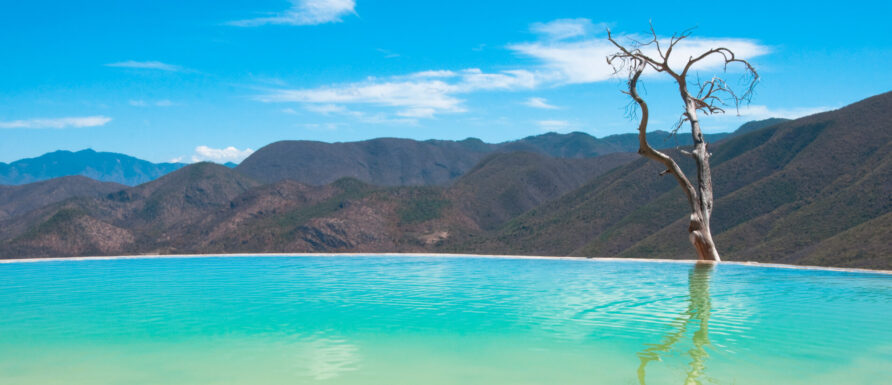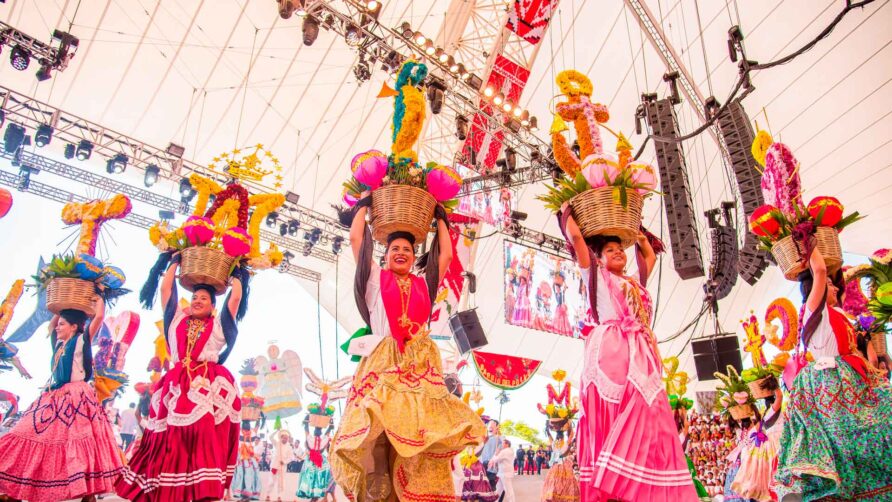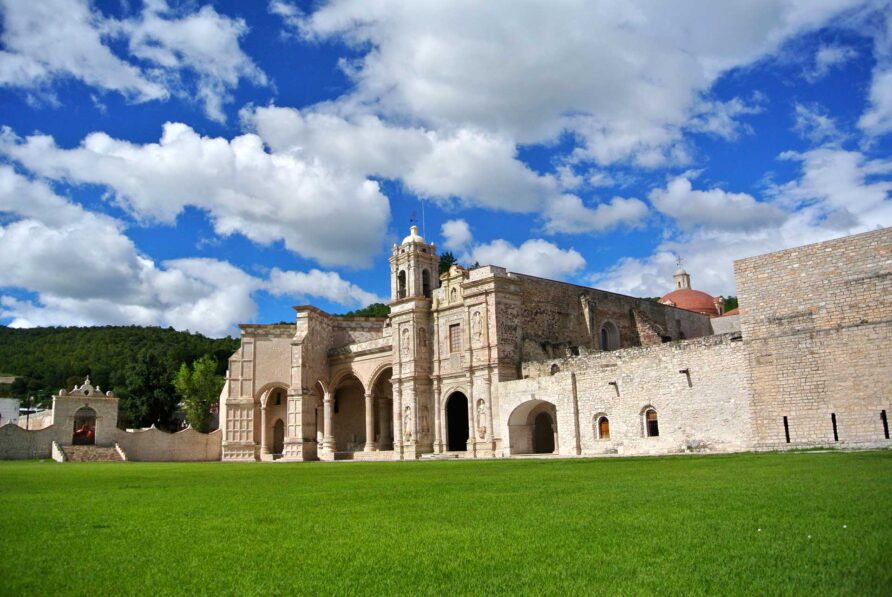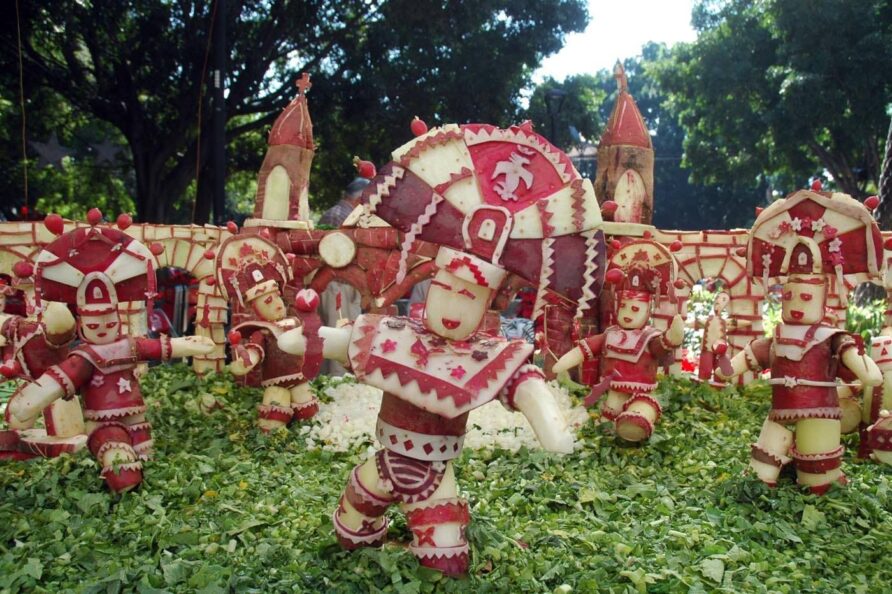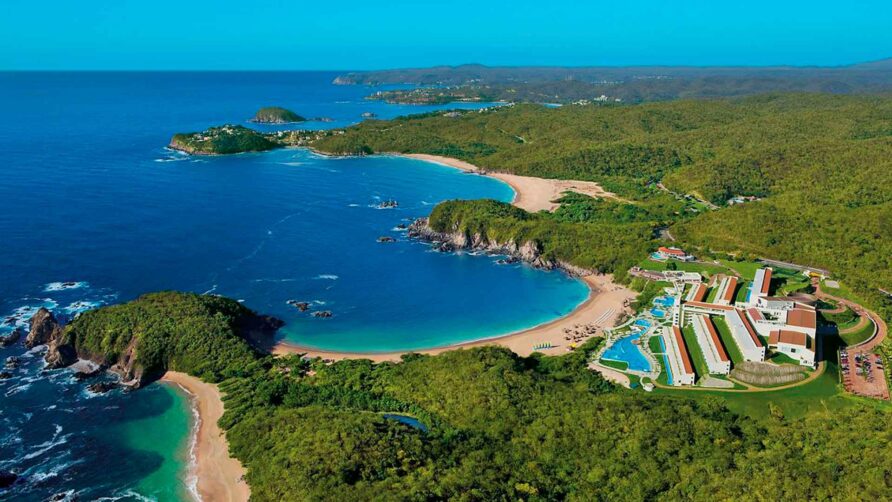Ro-House » Oaxaca » Archaeological sites
Oaxaca It is famous throughout the world for its archaeological sites and the history they keep. Discover Monte Alban, Mitla, Yagul and more of these remote sites, which have made Oaxaca a World Heritage city, according to Unesco.
The original Zapotec and Mixtec peoples of Oaxaca lived in the cities and religious centers of the valley of this city until the time of Spanish colonization. Today, there are still vestiges of these towns and places where you can meet them.

Archaeological Sites of Oaxaca

Monte Alban
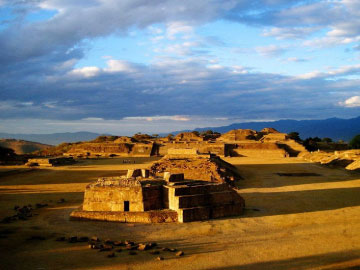
Monte Alban It is the most important archaeological zone of the Oaxacan entity, of unique regional importance due to the religious, political and economic control that the Zapotec state exercised over the population of the Valley of Oaxaca for more than thirteen centuries. It has been named by UNESCO Cultural Heritage of Humanity together with the city of Oaxaca on December 11, 1987.
The heritage of the Zapotec world reaches us through the magnificent archaeological sites designed in the Valley of Oaxaca. Of these, the city of Monte Albán stands out for its enormous importance as an economic, political and religious hub (it was the first urban complex in Mesoamerica); by its extension, almost as big as the current capital of Oaxaca; and for its long life, started around 500 BC and concluded around 850 AD
The city is surrounded by several mountains strategically located at the confluence of the arms that form the great Valley of Oaxaca. There are three groups that make up the site: Monte Albán, Atzompa and El Gallo, all configured by archaeological monuments on the peaks and by series of cultivation terraces on the slopes.

Mitla

Main ceremonial center after Monte Alban, the word Mitla o Mictlán is of Nahuatl origin and means “Place of the Dead” or “Underworld” in Zapotec it is called “Lyobaa” which means “Burial place”, which already in Mexica was left in Mitlan, “place of the dead” and already Spanishized only Mitla.
The archaeological complex and the current town are Zapotec, Mitla was inhabited from the classical period (100 to 650 AD) reaching its maximum growth and apogee in the post-classical period (750 to 1521 AD). The greatest attraction of the archaeological zone of Mitla is undoubtedly the varied ornamentation of its buildings, achieved through the system of frets that distinguishes it from those of the rest of the country.
There are five groups of constructions known as: Grupo del Sur, Grupo del Adobe, Grupo del Arroyo, Grupo de las Columnas and Grupo de la Iglesia. The first two are classified as ceremonial complexes, made up of mounds and central squares, the other three are classified as organized palaces with rooms around quadrangular courtyards.
Of the five the best preserved are the group of columns and the group of the Church. Group of columns: it is characterized by the use of monolithic columns from which its name is derived.
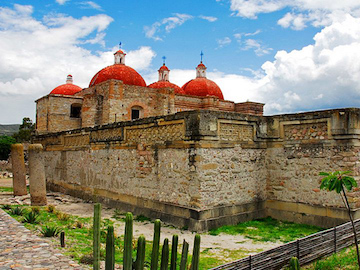
The great Hall of Columns has a rectangular plan. Through this hall you enter the main palace through a narrow door. Leaving the passageway we find ourselves in the patio of the frets, from where we will have access to each of the four rooms, decorated by three panels with mosaics of carved stone frets that form different geometric drawings on each band; the frets are made up of thousands of polished stone tablets, set together, without any mixture.
In the north and east buildings are the most beautiful tombs, where the Zapotec priests and kings were buried; in the first, in front of the staircase, there is the entrance to a cruciform tomb, with an antechamber; the ceiling has large monolithic stone lintels and the walls are decorated with panels and fretwork mosaics; the eastern one is characterized by a monolithic stone column that supports the roof.

Yagul
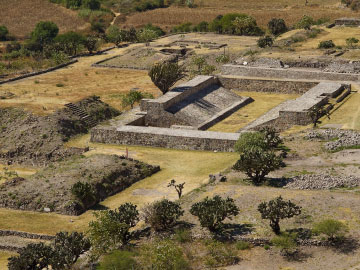
There is evidence on the occupation of Yagul from the time of Monte Albán l (500 years BC). It flourished as an urban center after the decline of Monte Albán (800 AD). Later, after a short abandonment, Yagul re-emerged to become a city-state, in the Oaxaca valley, which prevailed until shortly before the arrival of the Spanish conquerors.
This important pre-Hispanic center, whose name in Zapotec “Ya-gule” means “Dry Tree or Palo” has among its monuments the largest ball court in the Oaxacan region and the second in Mesoamerica.
It flourished as an urban center after the decline of Monte Albán, between 750 and 950 AD. Later, after a short abandonment, Yagul re-emerged to become a city-state, in the Oaxaca valley, which prevailed until shortly before the arrival of the Spanish conquerors.
This important pre-Hispanic center has among its monuments the largest ball game of the Oaxacan region and the second in Mesoamerica.

Dainzu
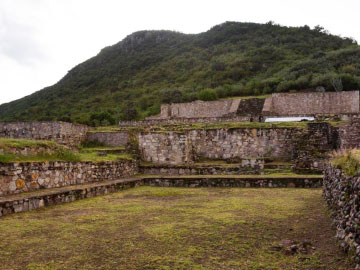
Dainzu It is an archaeological site of the Zapotec culture, located in the eastern arm of the Central Valleys of Oaxaca, 19 kilometers south-east of the city of Oaxaca de Juárez, capital of the Mexican state of Oaxaca. It is an ancient contemporary city of Monte Albán whose flourishing predated the founding of the metropolis of Los Valles.
The architectural style of this site is important because it presents structures with unique characteristics that distinguish it from the others in the Oaxaca Valley; These reflect a great artistic quality as in the lower platform of the Building A, in which a gallery of bas-reliefs representing ball players were captured. During its urban period, Dainzú functioned as a second-rank community in economic, political and religious terms. The main occupation corresponds to the transition period called II-IIIa, from approximately 250 to 350 AD.
Dainzú was built recharged on the hill, apparently for aesthetic reasons its original entrance was on the west side of the river. It had a long sequence of occupations from 600 BC to 1200 AD, although there is a possibility as shown by archaeological materials that the area was occupied before Monte Albán, the splendor of Dainzú, occurred between 600 BC to 200 AD according to the data of the examinations. The archaeological site of Dainzú is located in the vicinity of a tributary of the Salado River, in the Tlacolula valley, although there are some terraces and petroglyphs traced in the rocks of a nearby hill.

Atzompa
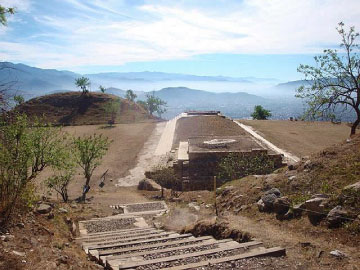
Atzompa, from Nahuatl, means 'At the top of the water' (atl 'Water'; tzontle 'hair', 'height' and summit ”; Y bread 'in' or 'over').
It was one of the monumental ensembles of Monte Alban. Its occupation goes from 650 to 900 AD A peculiarity of this archaeological zone is the existence of three courts for the Ball Game very close to each other, one of them 45 meters in length, which makes it the largest in the area including Monte Alban.
The court has a niche in each of the corners, which could be used as a repository for the offerings. Due to the type of structures that are located in this area, it has been interpreted that it functioned as a place for specific rituals, as well as the residence of Zapotec priests and rulers, perhaps belonging to a specific lineage.
The archaeological zone is not officially open to the public, in such a way that it does not have any type of services or infrastructure to attend to the tourist visit, only with two custodians who provide general information about the site and help in case of being necessary.

Zaachila
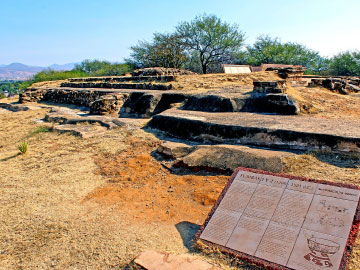
The archaeological zone of Zaachila It is located in the Villa de Zaachila, located in the Central Valleys of Oaxaca. It was founded by the Zapotecs, probably around the time when the construction of Monte Albán also began and the village of San José Mogote was flourishing. Although few remains of the ancient Zapotec site have survived to this day, they allow us to observe that Zaachila was a population that also played an important role during the Classic Period of the Zapotec culture.
Witness of this are the two tombs that are part of the city, built in a similar way to those that were built during the period of greatest flourishing of the city of Monte Albán.
The main attraction of Zaachila is precisely the tombs discovered on the site. They were built under an old palace, and their style corresponds to the Postclassic of Mesoamerica. The walls of the tombs are adorned with stucco figures that represent creatures related to the world of the dead, according to Mesoamerican mythology, including the owl. Other reliefs represent four characters of which two can be identified by their calendrical name. In the interior of the tombs, several polychrome pottery objects were found, which could have been produced by the Mixtecs or by the Zapotecs themselves under the influence of the former. Zaachila was founded around the 13th century after Christ. Understood in the post-classical period and after the decline of Monte Alban as a Zapotec city and capital.

Lambityeco
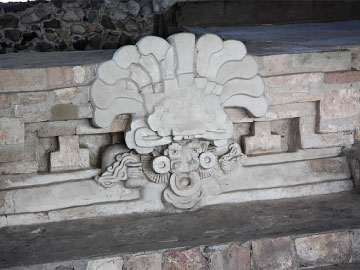
The few traces discovered indicate that the occupation of Lambityeco It occurred between 600 BC to 800 AD. It reached its peak between 700 and 750 AD. C., coinciding with the gradual abandonment of Monte Albán. Due to its salt production, in those times, it was considered an important city, within the Zapotec market.
The buildings that are found on the side of the road, is what has been explored so far in this archaeological zone. It is only a small part of what was this great settlement that covered approximately 63.75 hectares. Likewise, there are more than 200 mounds, not counting those that remained under the current town of Tlacolula.
The remains of the houses and palaces explored are a small part of the city. The oldest palaces are those of the chiefs and priests.

San Jose El Mogote
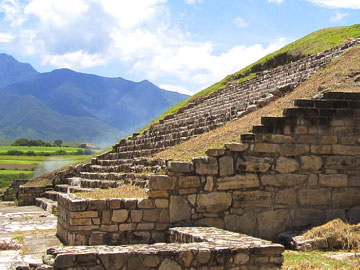
San Jose El Mogote it has been around for more than 3,500 years. It was possibly the first town to be founded in the village stage, and it was the largest of that time. It includes lands of Guadalupe Etla, the entire San José Mogote agency and lands of San Sebastián Etla. Here, for the first time, the predecessor cultures of the famous city of Monte Albán were defined. During the heyday of this center, San José Mogote served as the head of the Etla Valley. It also had its palace, its temples and its ball court. It was abandoned around 400 years before Christ. Shortly before the arrival of the Spaniards it was occupied again, as a small peasant town.
It is presumed that the founders of Monte Albán were also inhabitants of San José Mogote. Inscriptions found at the site document one of the oldest forms of writing in Mesoamerica, dating back to around 500 BC.
Archaeological remains show that the city was inhabited for at least 1000 years. The population went into decline towards the end of the Middle Preclassic, at the same time that Monte Albán took hegemony in the Central Valleys of Oaxaca. It was finally abandoned towards the end of the Late Preclassic.

Huamelulpan
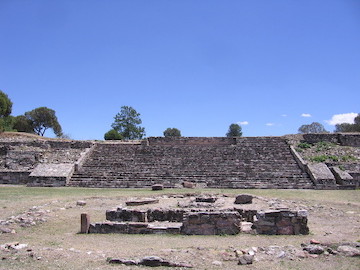
This Archaeological Zone sits on a hill known as Yucunindaba, which in Mixtec means “Cerro Volado” or “Cerro que Volado”.
Huamelulpan is distinguished by its monumental architecture and sculpture, as well as by its calendrical inscriptions. Its occupation has been divided into three periods: Huamelulpan I, from 400 to 100 BC. C .; Huamelulpan II, from 100 a. C. to 200 d. C., in which it had a great demographic expansion, and Huamelulpan III, from 200 to 600 d. C., period in which its size decreases but the construction of buildings continues. The city was built on a hill-hill system with terraces on the slopes of the aforementioned natural elevation. It was organized in monumental architectural ensembles separated into three main and two secondary nuclei.
The site is divided into five architectural areas: Grupo del Cerro Volado, del Panteón, Iglesia Vieja, Poniente de la Iglesia and Grupo de la Iglesia. Due to the predominance of several hills and hills that surround the environment, the various constructions were adapted to this type of terrain, building a system of terraces of simple houses with stone foundations where the common population lived, in other cases the public and ceremonial areas they are distinguished by having large stone platforms offset in a staggered manner delimiting open spaces. In the lower part is the building ball court related to a ritual that usually culminates in human sacrifice.
In the group to the West of the Church on the southern slope there are huge platforms whose corners were reinforced with rectangular stone blocks weighing several tons and where there are engravings with calendrical signs very similar to the Zapotec writing system observed in Monte Alban.

Guiengola
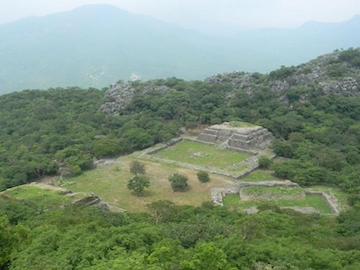
The Guiengola toponymic has two meanings, the first derived from the Zapotec language of the isthmus, composed of the words guie: stone and gola: great or old "Big Rock" and the second "big or old hill" according to Danyroó.
The city of Guiengola was built by the Zapotecs on a natural elevation, which together with the constructions made by its inhabitants, created a settlement difficult to be invaded. According to the ethnohistoric and archaeological data, this place was occupied by Mixes, Zoques, Huaves and Chontales, when they were attacked by other groups that came from the Altiplano and southern Mesoamerica. It is believed that the city was still functioning at the time of Spanish contact. In addition to the fact that it was the scene of an important battle between the Zapotecs and the Mexicas, it contains notable architectural evidence.
The full extent of the city is unknown because little has been explored; Among the visible architectural ensembles, the Main Plaza is made up of 2 pyramidal bases and the ball court accompanied by other smaller constructions, these buildings were intended for public and ceremonial activities, and by the regular ones they were associated with the worship of divinities, but there are also other relevant sets such as the Palace that can be defined as the headquarters or place where the ruling or priestly class lived and is made up of a series of platforms, patios, rooms, warehouses, tombs and access stairs, and even wells of water or temazcales where the degree of elaboration and refinement of the architecture predominates. Its main chronology is Postclassic around the year 1350 AD. C.

Mouth of the Copalita River
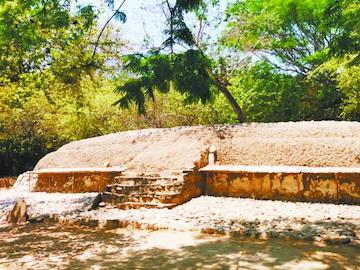
Copalita. Nahuatl term that means Place of Copal. This site is located on the western bank of the Copalita River, very close to the tourist development Huatulco bays. The first occupation of this pre-colonial settlement dates back to the Middle Pre-Classic period (600 BC). At this time, the construction of ceremonial platforms and residential terraces on the hills adjacent to the sea cliffs was manifested.
The classical period is the heyday of this city where there is already a ceremonial center that contains a ball court and a main building more than 20 meters high and which in turn contains, up to now, two tombs associated with the elite ruler.

Cerro de La Campana (Huijazoo)
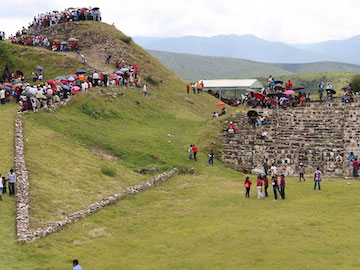
It is located in the extreme north of the Etla Valley in the Cerro de la Campana, just 30 km from the City of Oaxaca.
The chronology indicates that the founding of Huijazoo dates back to 1450 BC, and its abandonment in AD 300. The site was an important ruling center of the western part of the Etla Valley during the classical period (250 - 800 AD). It controlled all the trade that took place in the region.
Huijazoo, like Monte Albán, is built on a hill.
The archaeological complex is made up of temples, palaces, a ball court, squares, shrines and tombs. In the highest part of the terrain there are three large platforms, of which two of them are aligned with the west-east orientation.

More Tourist Attractions in Oaxaca
Crafts in Oaxaca are so varied and of such good quality that they have become a tourist attraction. The ancestral traditions, the diversity in the ethnic groups, as well as the richness in the history of the state have been manifested in the great diversity of creations of more than half a million artisans that are registered in Oaxaca. In the center of the state is the City of Oaxaca, a fascinating and hospitable capital in whose surroundings various towns are located, each with its own personality and craft tradition, accompanied by their respective customs, festivals and dishes.
Oaxaca City, the state capital, is famous for its architecture and rich cultural traditions. Oaxaca also has a splendid and varied cuisine and a spring climate throughout the year. UNESCO declared the city a Cultural Heritage of Humanity. Oaxaca is the most diverse state in Mexico. It has peaks that reach more than 3,000 meters in height, caverns that are among the deepest in the world, pristine beaches, secluded forests and sunny valleys. Oaxaca is rich in traditions and customs and has the largest ethnic population in Mexico.
The vast Oaxacan cuisine is distinguished by its tradition and the use of regional ingredients. Not for nothing has it positioned itself as the Best Tourist City in the World and the Best Gourmet Destination. In the presentation of the 2021 edition of The Mexico Gastronomic Guide "The Great Restaurants of Mexico" 278 restaurants located throughout the Mexican Republic were recognized, on this occasion, there were 16 Oaxacan restaurants that were placed in the list .
Monte Albán is the most important archaeological zone of the Oaxacan entity, of unique regional importance due to the religious, political and economic control that the Zapotec state exercised over the population of the Valley of Oaxaca for more than thirteen centuries. It has been named by UNESCO as Cultural Heritage of Humanity along with the city of Oaxaca on December 11, 1987. The heritage of the Zapotec world reaches us through the magnificent archaeological sites designed in the Valley of Oaxaca. Of these, the city of Monte Albán stands out for its enormous importance as an economic, political and religious hub (it was the first urban complex in Mesoamerica); by its extension, almost as big as the current capital of Oaxaca; and for its long life, started around 500 BC and concluded around 850 AD
An ideal space for Alternative Tourism, Oaxaca offers activities such as walking, mountain biking, rappelling, climbing, zip-lining, horseback riding, observation of flora and fauna and more, in close contact with nature. The visitor can also witness the various aspects of local life, savor the gastronomy and enjoy the warmth of its people, as well as an offer of accommodation in hotels, ecotourism cabins, local houses or excellent camping areas. In its varied geography, it brings together not only a vast biodiversity, considered among the largest in the world, but also insurmountable cultural and ethnic riches, and the most different and beautiful natural settings.
The Santo Domingo Cultural Center is a cultural complex that is located in what was one of the most important convents in the colony. It is a large convent in which the Museum of the Cultures of Oaxaca, the Fray Francisco de Burgoa Library and the Ethnobotanical Garden have been established. The Néstor Sánchez Public Newspaper Library is located in a building that is part of the complex but dates from the 19th century. Apart from all these institutions brought together, the Santo Domingo Cultural Center has multipurpose spaces in the former convent, in which temporary exhibitions, conferences, courses, book presentations and concerts are held, among many other activities.
Oaxaca's culinary tradition is extraordinary and deeply rooted. There are fourteen different ethnic groups, with their own dishes. It is an area of incomparable wealth for the tourist interested in gastronomy, ethnology and culture in general. Oaxaca is the land of mezcal, tlayudas and the famous seven moles. You have to dedicate several days to it. Oaxacan gastronomy is one of the cultural manifestations that identify and define its people, due to its variety, richness and complexity that have been preserved through the centuries. The best way to enjoy Oaxacan food is by tasting it, from the “strong” dishes that are used to enjoying at lunchtime; like the traditional Oaxacan snacks that can be enjoyed at any time of the day.
The City of Oaxaca is a destination that offers a great variety of tourist attractions and charms that leave anyone surprised. However, there are other places that are also worth knowing and are in the surroundings of the city, in whose surroundings various populations are located, each with its own personality and artisan tradition, accompanied by their respective customs, festivals and dishes. .
The Guelaguetza is an ancient tradition with pre-Hispanic roots related to agricultural ceremonies of gratitude to the gods for the arrival of the rains and the lifting of the harvest at the end of July and is the largest festival in Oaxaca. La Guelaguetza is a celebration of gratitude for the arrival of the rains and the harvests, in which representatives from all regions of the state gather in the capital to share their culture through dances, crafts and food.
In Oaxaca we are proud to have 5 communities that have been awarded the title of Magic Towns of Mexico, a Magic Town is a town that has symbolic attributes, legends, history, transcendent events, everyday life, in short magic that they emanate in each of their socio-cultural manifestations, and that today mean a great opportunity for tourist use. The Magical Towns Program contributes to revalue a group of populations in the country that have always been in the collective imagination of the nation as a whole and that represent fresh and different alternatives for national and foreign visitors.
The name mezcal has its roots in one of the ancient native languages of the area and translates as 'agave (also known as maguey) cooked'. Although pre-Hispanic Oaxaqueños used maguey to make pulque (an undistilled alcoholic beverage), it seems that the real advances in mezcal production occurred when the Spanish arrived in Oaxaca; by bringing with them their knowledge of distillation processes.
In the state of Oaxaca there are many customs and traditions throughout the year, and within the state, said that they have the same purpose of celebration but with different things, in fact from one region to another or even more from one town to another, the Customs vary for perhaps details but that is what makes them authentic. Oaxaca has deep-rooted customs and traditions. All the holidays are celebrated, the profane and the religious ones. The festival calendar is extensive due to the diversity of ethnic groups, which they still conserve.
The beaches of the coast of the state of Oaxaca are among the most beautiful and complete in Mexico, thanks to a developing tourist infrastructure and the rich gastronomy of the Pacific. Along the 533 kilometers of coastline, the beaches of Oaxaca offer a wide variety of activities for lovers of water sports: snorkeling, diving, sport fishing, surfing, among others ... there is something for everyone!
Places such as Puerto Escondido, Mazunte, Zipolite, Carrizalillo, Puerto Ángel or the beaches of Huatulco will offer you the possibility of contemplating beautiful sunsets, delighting in intense adventure tourism or witnessing the exciting release of newborn turtles.

Guided Tours in Oaxaca


